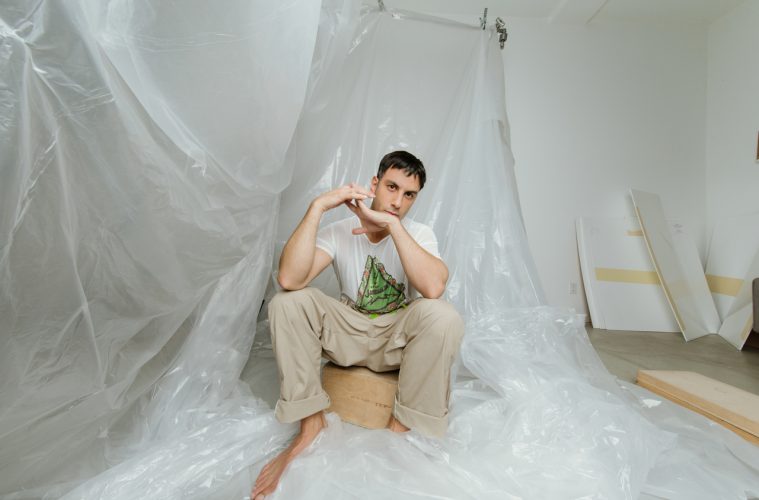Interview by: Sami Abdelbaki
Photographed by Jiyan Zandi
Photo Assistant: Salma Soliman
Styled by Hushidar Mortezaie (Trashy Clothing x Hushidar Mortezaie)
Art design by Mo- Mouselli
Cover design by Atef Daglees
This article is part of the “Hopefully Tomorrow” issue
Born in Syria, raised in Sweden, and based in London, Jwan Yosef is constantly engaging themes of identity through his art. He describes himself as an immigrant of the world, an immigrant in every country he’s lived in. His art, which is mostly based on and inspired by marginalized groups, tackles themes of identity and belonging. Drawing inspiration from his external and internal worlds, Jwan retells and reframes stories and images we are told to believe, and draws inspiration from his experiences as a queer person and love for his husband and children.
Like him, his work is conceptual and crosses borders and combines worlds that break with the limits of traditional art production, balancing between the conventional and unconventional. Jwan never gives you the full picture in his art; he presents hints or traces that, like following a trail of breadcrumbs, might lead you to the meaning(s) of the work or keep you searching. In his series, Object (2014), Jwan stretches pieces of canvas frames without covering the entire area, ending up with incomplete works of art. Perhaps we could see his work as self-referential, because, like his paintings, Jwan is most comfortable in-between states and identities, close enough to many but not limited by any.
There are many layers to Jwan — his sexuality, his religious point of view, his upbringing, his heritage — all of which refract through his art practice and create honest works of art. Not only this, but he is a father, a husband, an artist, and an Instagram icon. Jwan simply does things differently in a world where we’re always pressured to find ourselves and our place, and after a long quest in search of a place he belongs to, he’s creating one for himself.
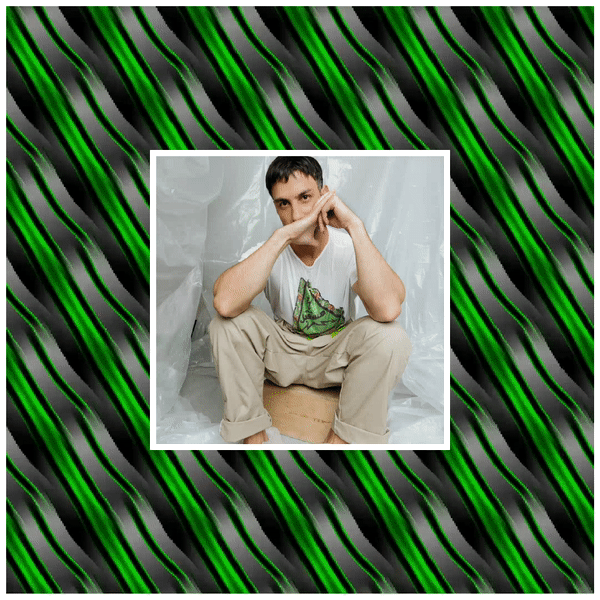
Photographed by Jiyan Zandi. Art design by Mo-Mouselli
Hello Jwan! It’s so exciting to have you on board for the new issue. I know many Arab queers are excited for this. How do you feel having a large Arab queer following base that looks up to you?
To be honest, it’s surreal. I grew up in Sweden most of my life, and having a following base from the queer Arab community is something I would’ve never imagined. It brings an extreme sense of pride, but also a great wake up call from my heritage. There’s a sense of pride coming from Syria and being able to represent in a way a marginalized group that always existed in the culture but in a different veiled form.
Can you tell us a bit about your upbringing as a queer Syrian person?
I look fondly at my childhood. I was born in Syria, and immigrated to Sweden with my family in the 1980s, when I was 2 years old. My parents’ marriage was an unconventional one back home in Syria, my mother being Christian and my father being Muslim. That set the tone for a pretty open-minded and unusual upbringing in Sweden. We remained very much Arab, yet my parents were very keen on us assimilating into Swedish society. We were not surrounded by many relatives, so we got close to family friends that had moved to Sweden from Qamishli, my parents’ hometown.
As a queer kid, I had a very safe space with my family, friends, and at school. I was “feminine” and went through the ‘casual’ teasing by other kids, but was generally supported and not really called out for being ‘queerish.’ My parents were very open-minded and played with me while I played with my dolls, never making me feel ‘off’ in any way.
I think I did all things differently as a kid. I was always painting and I played the saxophone (out of all instruments). I played with dolls, danced with girls, and sometimes dressed up as a girl; I loved dressing up in dresses. Culturally, as a Syrian, I guess I was fortunate that I never grew up with the pressure that comes with close relatives and their inputs; as per usual Arab culture, it has its ups and downs. It can be an immense support and sometimes a downfall. In retrospect, I am somewhat happy we kept our relatives at a distance, but I am happy to now reconnect as a grown and developed person.
Did you ever visit Syria again after your family left?
I have tons of family between Qamishli, Aleppo, and Damascus. We used to visit them every other year until I was 14, so I have tons of memories from when I was in Syria. It would be like a state visit every time — we’d go from family to family visiting everybody and stay for a month or two.
I haven’t visited Syria since my teenage years because I never got a chance to get back. When I was 25 living in London, I felt the biggest urge to go to Syria because I was grown up in a way, but then the war started and the dream to visit sadly died with that. It hasn’t died completely, however, and I’m super keen to go back but also to visit Damascus because I’ve never been there but I’ve been all around the Northern parts in Syria.
I would love to show Syria to my family. I was just sitting the other day with my husband , talking about Damascus and making dreamy plans to take our kids there and discover Syria. There are so many amazing parts of it that not only do I feel like I need to show it to my family but also to rediscover myself.
“The further away I am from Syria, the more Arab I feel. It’s the way I look and act and speak”
Jwan Yosef
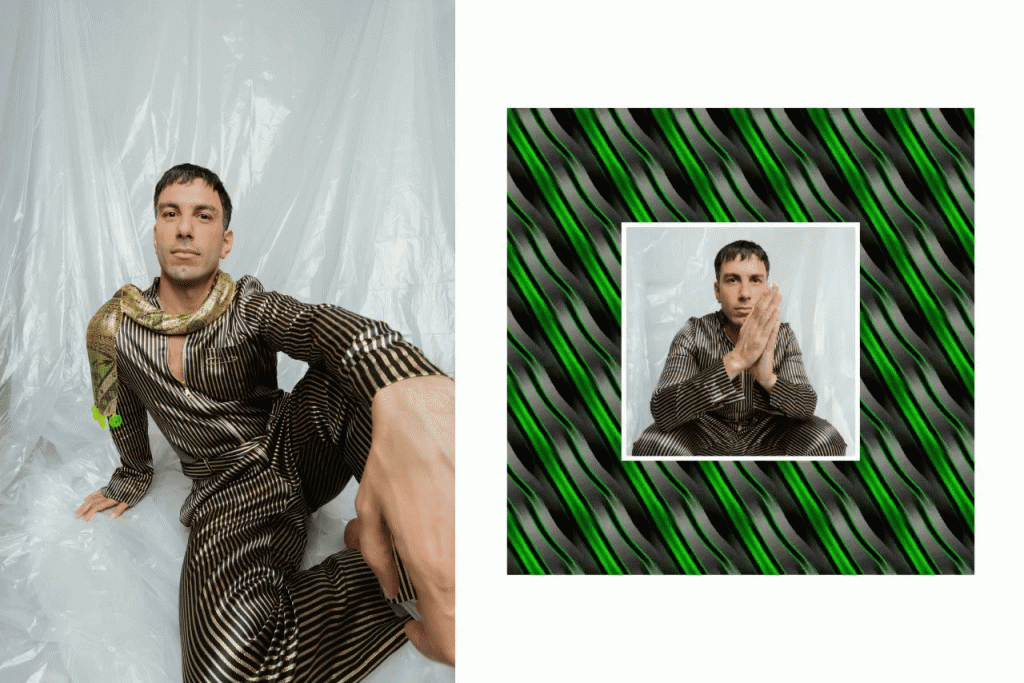
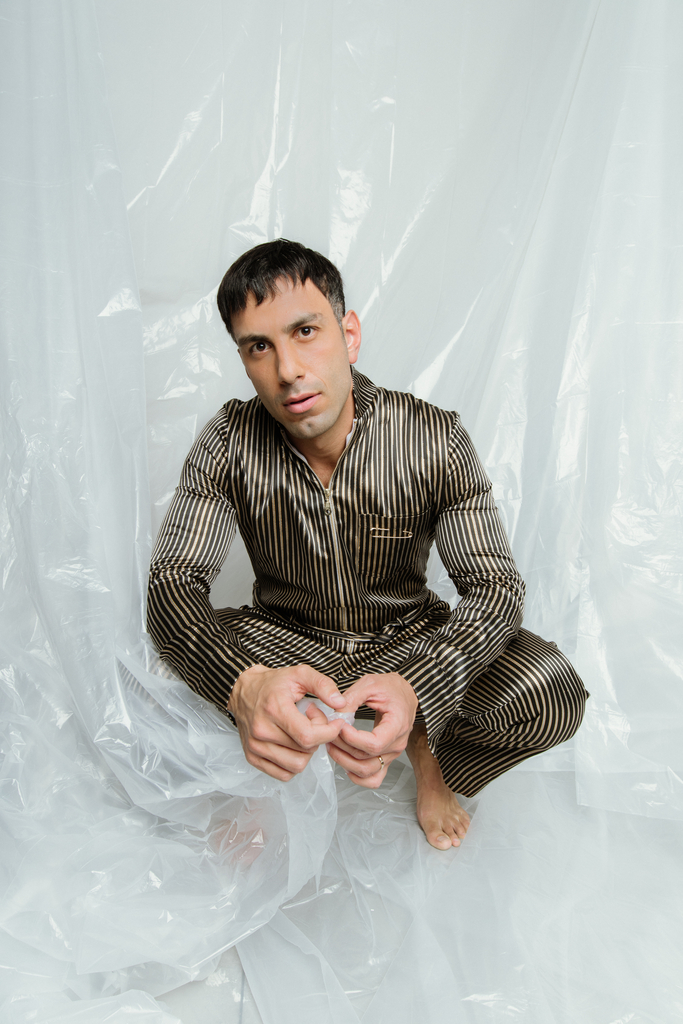
Photographed by Jiyan Zandi. Art design by Mo-Mouselli
One thing I noticed is that you don’t shy away from talking about your Arab roots. How does this part of your identity come through in your everyday, despite having lived all over the world?
I think not only was I taken out of the country at a young age, but I was also taken away from my extended family in Syria. We were distant not only from the country but from our family there. There’s this extreme urge to form a sense of identity around my heritage. I am in so many ways a Swedish person but in my core, I always come back to being Arab. It’s something I’ve never wanted to or tried to avoid. The way I bring up my babies is that I focus on Arabic rather than English or Swedish. I taught my kid how to count to ten in Arabic and she’s only 2, which is wonderful. The further away I am from Syria, the more Arab I feel. It’s the way I look and act and speak. Those things come from a core that comes from my parents. We were a very assimilated family in Sweden, but at the same time, our mannerisms are very much Syrian. I think my husband married me because I’m an Arab man. My strongest attribute is that I am who I am.
Building on that, as a Kurdish/Armenian/Syrian-born Swedish artist living in London and LA, how much does a place/identity affect your art?
I have been an immigrant all of my life, and of course different places affect my work significantly. The move from Stockholm to London marked a major shift in my practice because I found a broader variation of artists, and new discoveries there would also impact my experiences of queerness. London was a kind of haven, and there was no end to the possibilities. But more than changing my practice, my time there was about solidifying my role as an artist and entity in the art world. My move to Los Angeles taught me to think big. Spaces in LA are bigger, days last longer and daily activities are a lot less stressful—that alone opens possibilities for a different form of art. I experimented more and branched out to installation work, and started thinking outside the canvas frame on a much larger scale, combining sculptural work with painting and ‘ready-made’ objects. It has grown into a very adaptive art practice, mirroring the place I’m in at all times.
You often work with different mediums and materials away from the common well-established methods of creating art. Can you tell us more about your art practice?
I would like to think of my painting as a self-reflective form of painting. While I am a painter at the core, I struggle to justify painting in its pure form; it is within that friction that I find myself and my practice. I always weigh how my own body relates to the art material I work with — it is the essence of each work — and I often tend to get stuck in that bubble of intricacy and form of portrayal. Sometimes I like to think of my role in creating the work as a dissected portrait painter, probing the lines and boundaries which render a portrait: recognition, signifiers, meaning, memory, and power.
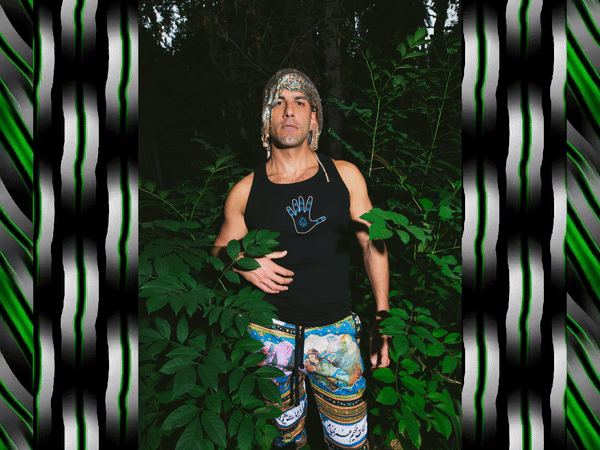
Photographed by Jiyan Zandi. Art design by Mo-Mouselli
From where do you draw inspiration?
Both my job as an artist and my experience as a queer man compel me to look for and reconsider the stories and meanings society imposes on material, objects, and people. I draw inspiration from the everyday world, whether that’s rethinking an image in portraiture or even the hierarchy of artistic materials, giving a ubiquitous material like tape a different role in the piece. I love repetitive behaviors, whether it be an act stemming from compulsion, ritual, or simply remembering. It’s the practice of revisiting and repetition that moves my work to procreate itself. I often return to use my previous imagery in a loop. It can be hard to determine what curious nuances will compel me to revisit an image, but it often manifests in a found image or a simple physical movement—and that guides me to create these paintings. I love to recycle images and pull out a detail out of an already made photograph or screen capture, enlarging it and shifting the focus. I have so many inspirations, they are often banal objects that in a superimposed situation become something worthy of attention: a piece of art.
[Jwan is also a founding member of The Bomb Factory Art Foundation in London, a non-profit foundation that aims to support artists through providing affordable studios, exhibition space and peer collaboration, and to provide cultural organisations and educational institutions a space to engage people of all ages and backgrounds in the viewing and creation of art.]
Jwan, can you speak more to why you started the Bomb Factory Art Foundation, and how it spoke to the needs of the London art community?
I needed more affordable studios to work in, and my friend and fellow artist, Pallas Citroen, had found this abandoned Victorian Bomb Factory in Archway, London. We decided to revamp it and build into this studio space and art foundation. The idea was to incorporate very established artists together with upcoming artists and to create an organic dialogue within that space. I am super proud of what we accomplished and how well the program has been doing these past years.
Do you think you might venture into the world of digital arts one day?
Yes, but I’m not really sure in what form exactly yet. I’ve always been a painter but then I ventured from painting to sculpting and installation work all within the conceptual form of painting. During my first bachelors, I was doing video work. I did digital pieces that were shown as videos in combination with painting. I remember in my earlier days as a painter, I had to convince myself why painting was still relevant, why is object form of art still important when you can express it in so many ways. With all of the digital forms that are coming out nowadays, it’s becoming harder to make such art forms valid. But it would be crazy to ignore one form in order to accept another art form, it’s not really about that kind of challenge.
I remember going to the Venice Biennale five or six years ago and there was a huge satellite show in one of the shipyards right across the Biennale, with 10 artists showing strictly digital arts. It was a pretty insane experience. They were incredible digital works of art and video work. I remember walking into that show thinking “wow, this feels like today and the biennale I just walked through feels like yesterday.” I couldn’t put a ring on it but it felt relevant. It’s not too representational, it’s not too accepted yet. In a very short term, it still does feel avant-garde, and I think an artist must always be avant-garde.
To put it simply, I think it’s impossible not to venture into digital arts these days, especially in this pandemic where digital experiences of art have been the go-to place. But it also shows the need of showing and communicating art, if you can’t be in a specific place or museum or gallery, where would you go? The digital sphere is the most evident place to be in right now. The idea of a magazine, a catalogue, an object is slowly becoming redundant. Social media in all its platforms is based on digital expression.
Speaking of social media, you’re very active and you’re always building connections with your audience. Does this actively affect your work?
Social media is a stellar way for me to reach out in all aspects of being an artist. It is funny because in past times, putting a face to an artist/painter was a challenge, I would say I’d recognize very few artists by their faces. Social media has allowed us to engage with artists and the complexities of their identities in a different way—their personal backgrounds, places, politics, contexts, studios and all of life’s peripheries that are not displayed on gallery walls. It demystifies the figure of the artist, but also keeps the work honest. It opens opportunities for artists and artist communities once considered ‘outsider.’ I think today, to recognize an artist by both their art practice and who they are as a person has changed partly thanks to social media. It’s also been a great tool for me to reach out to an audience that isn’t necessarily connected to the art world. It’s almost a democratization of what otherwise might appear as a closed set. What you also understand is that conceptual painting isn’t always fully understood by the general public, with this platform I realize that I work in a very foreign line of work and that sometimes it might need translation. Sometimes I need to translate it for myself in order to deliver it.
I always wanted kids. When I first came out to my mother when I was 20, she was very accepting but her only sorrow was that she’s not going to have grandchildren.
Jwan Yosef
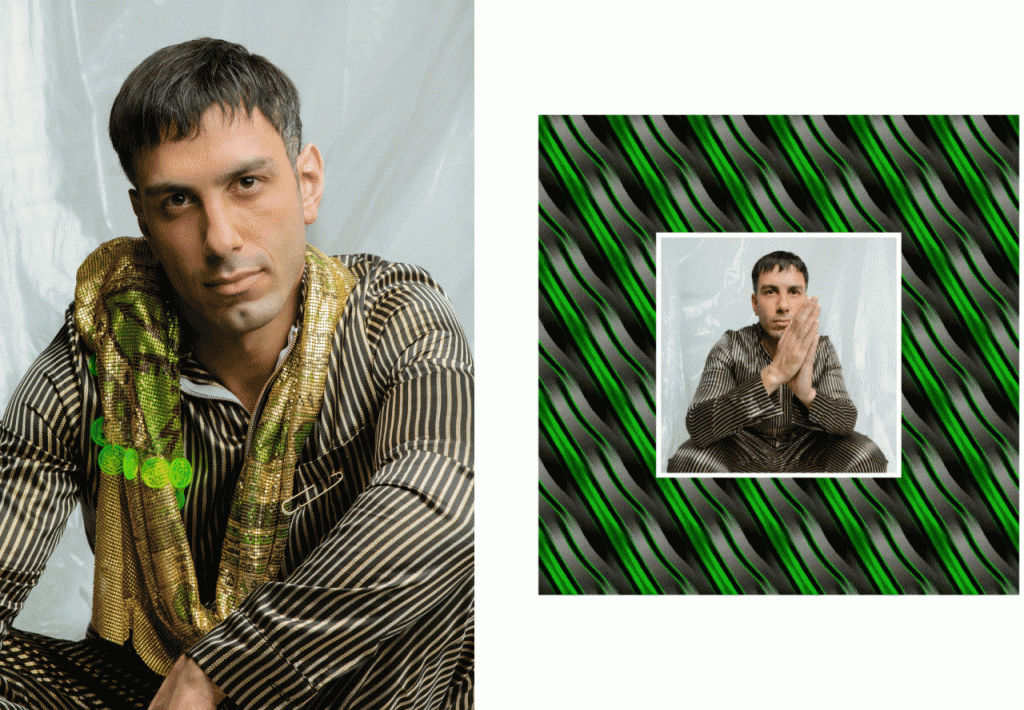
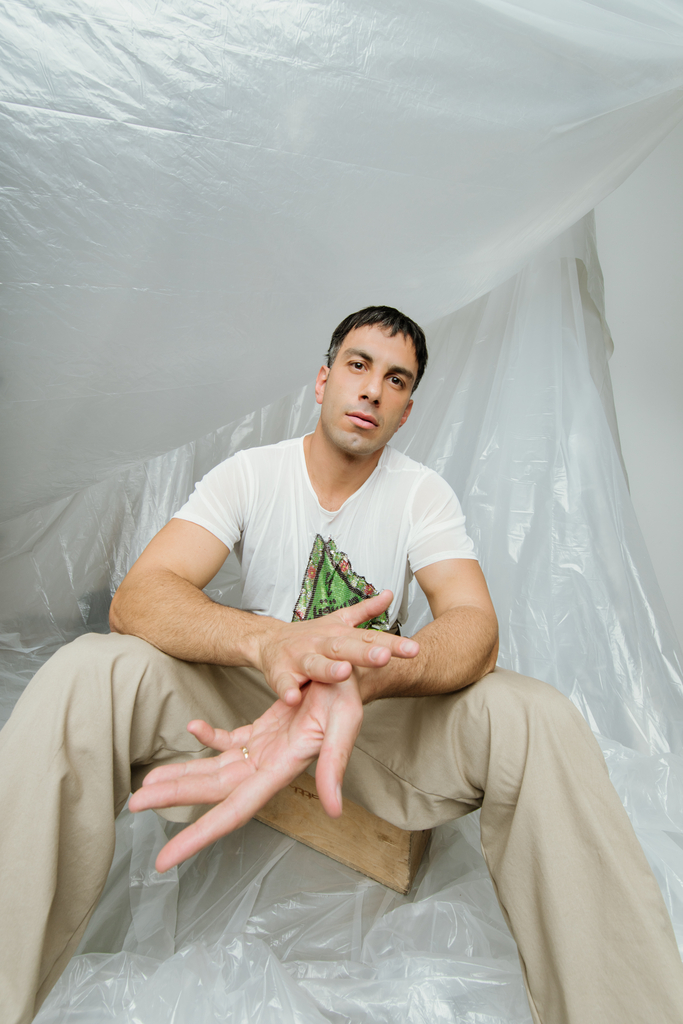
Photographed by Jiyan Zandi. Art design by Mo-Mouselli
Shifting more to the personal, can you tell us more about your beautiful relationship with your husband, Ricky Martin? How did it all start?
He’s an art collector, so one day he wrote to me on Instagram regarding an art piece I had made and he wanted to know more about it. It felt surreal. It was like a modern day Jane Austen story in a way, we spent six months talking strictly about art, life, creativity, music, but nothing sexual until we met. When we met after six months of talking and learning so much about each other, it was like meeting a soulmate. It was a very classical form of meeting, exchanging letters for six months. I’m not necessarily a romantic person but this was very romantic.
You now have four precious children. Did you ever imagine yourself becoming a father?
I did. Maybe not a father of four children, but I always wanted kids. When I first came out to my mother when I was 20, she was very accepting but her only sorrow was that she’s not going to have grandchildren. I had to explain to her that those are two different things. I’ve always imagined either adoption or surrogacy, and thought I’d be a great father.
It’s like a dream having kids. I have two beautiful step-kids and my two babies, and it’s a full-on Syrian house. I was 30 when I became a step father, which sounds a bit young, but I was somewhat ready for it. With my babies, I aged 20 years these past 2 years. It’s the best job in the world but you have to want it, otherwise I wouldn’t recommend it.
Was it difficult to enter your husband’s life considering the circumstances and his lifestyle?
It’s a big leap. It’s an extraordinary lifestyle in every aspect, and the ups are big and the downs are equally as big. There are a lot of people involved, and it’s more about dealing with the big community when it comes to celebrities. But I think we kept things very private between us for a very long time and gave ourselves a chance to really know each other before it exploded into the news. So the truth is, we gave it time. I gave myself time to ease into this very public life. It was overwhelming but also a very calm experience, to put it in a good context. It’s not as crazy as it might seem.
What about your family? How did your family embrace the relationship?
My parents knew a long time before the public knew. The biggest shock for them was when he announced that we were engaged on Ellen and my parents found out about the news on MBC, LBC and every Arab media platform. They’ve been super supportive. I have cousins, aunts, uncles who have been very welcoming.
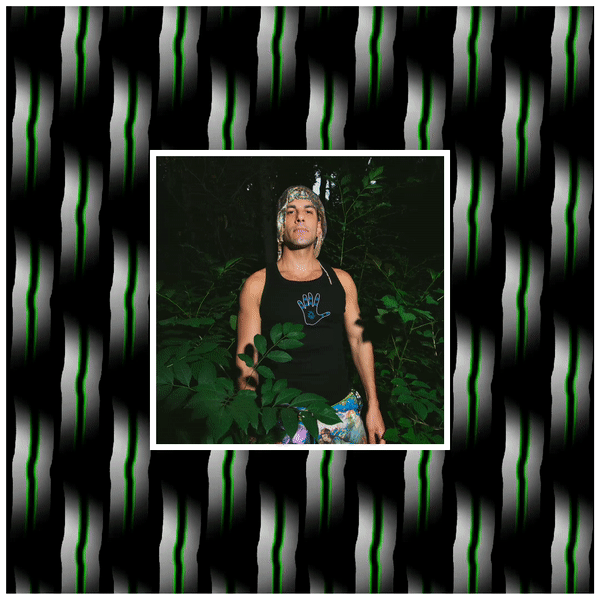
Photographed by Jiyan Zandi. Art design by Mo-Mouselli
How was it for your family to meet your now husband for the first time?
Ricky and I flew to Stockholm, this was in the early stages. We had arranged for a full day at my family’s house and it was a very humbling experience. It was a pretty normal first-time meeting partner’s family experience. It was super fun, cute, and awkward. The truth is, he’s Puerto Rican, I’m Arab, our families are very much alike: we’re loud, all over the place, we’re in each other’s business. It’s a pretty easy translation to make.
To be queer is something that many families can handle, but being publicly queer is another conversation. Did such conversations ever take place?
I think this is the biggest fear in Arab cultures. The family can contain and accept most things, but it’s always the fear of extended friends and family. My parents had to have a lot of conversations with their immediate families, but I have to say it was a very accepting experience overall, although it could’ve gone wrong or been more complicated. I’ve been really impressed by my extended family in Syria, Sweden, America, and all over the world. They have all, in different ways, truly accepted this marriage in very different ways. I would’ve imagined the worst, but they brought the best from themselves. I have to give them kudos for that because they opened my eyes to understand that acceptance is much more than where I live or come from, you can find it anywhere. It’s universal. If you apply love anywhere, acceptance comes naturally. I’ve seen people who I thought would be extremely conservative open their arms to me and my husband in the most beautiful way which makes me happier prouder to be Syrian. I’m also absolutely not to blind to the situation of the completely different cases, which in effect is the majority of the cases, I have great friends that deal with bigger problems than I have. Friends that had to immigrate to another country just to survive. There are ups and downs of being a public figure. I’m so glad that so far it’s been a positive experience.
The pandemic has affected families and artists alike around the globe, for better or worse. It seems like it potentially offers a chance to create more or create differently, or to step back for a while. How has the pandemic affected your work?
Because of the unprecedented scope of the pandemic’s global tragedy and severity, I decided not to work for a few months to take this forced leave and pause and reflect. It was a great time to reevaluate my priorities and focus on myself and family rather than work. The work and ideas slowly started coming and I became, for obvious reasons, a lot more “surface conscious,” and I’ve actually been working on a new work that is very surface aware.
Though these times are still uncertain, I am maintaining hope and optimism for the future. I’m excited as to what’s to come and also how we in the future will relate to art and objects differently in general. It would be insane not to take a sharp turn in my practice after this pandemic. I hope that we artists don’t let this time just pass by, but we take these new lessons of proximity, distance, community, touch and care of others to our work and find our power to use creativity to connect with each other in new ways.
Along with the theme of the issue, “Hopefully Tomorrow,” how do you imagine the art scene post-COVID?
I imagine a lot will and most definitely has changed already, I’m seeing a very strong move to a digital way of approaching the arts. I think the need to showcase creative work is stronger than any boundaries of a pandemic. The reality is that I’ve had more productive virtual meetings and collaborations than ever before, and this speeds up creative processes. We might be showing less now, but the workflow has definitely increased and that is hopeful to me. What is art if not a form of communication, and if you can communicate outside the walls of a museum or a gallery that is ultimately what you would want with your practice.
What are your upcoming projects?
I’m planning on some larger projects and collaborations coming up for next year and all the way to 2023, which I’ve never really done before, making work and looking at a timeline that is so far ahead, there’s something great about having so much time to prepare. I’m curious myself to see how the work will develop. But the closest project would be that I’m showing at the Bomb Factory in London in Fall 2021, assuming and hoping things will get better with COVID times.
What makes you hopeful for the future?
My children. I look into their eyes and I imagine how much power they have within themselves and what a tool I will be for them in their path to change the world, that’s what gives me hope.

